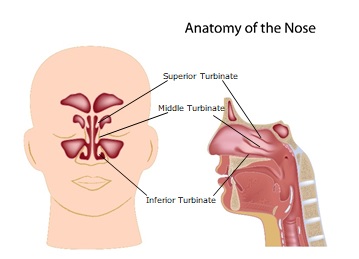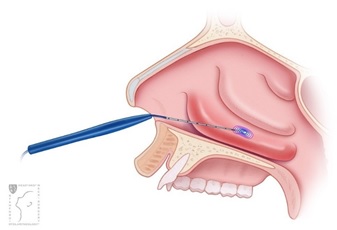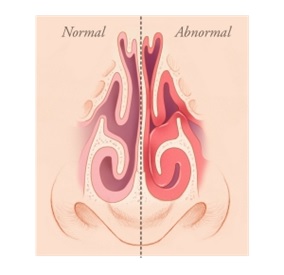What is the Inferior Turbinate?
The turbinate is a structure located inside the nose, along the side of the nasal cavities. It is made of bone and is covered by soft tissue known as “mucosa”.
The human nose has three pairs of turbinates (superior, middle and inferior) (Fig. 1)

Fig. 1 Front and Side views of the turbinates
The functions of the turbinates are to humidify, warm and direct the air as it passes through the nasal cavity. It also produces mucous that traps dirt and bacteria in the air.
The inferior turbinate is the lowest-most turbinate and is also the turbinate which can cause significant nasal blockage (‘blocked nose’) when it is enlarged.
The size of the turbinates varies with time and temperature. For people with sensitive nose (allergic or non-allergic rhinitis), the turbinates can constantly be enlarged.
What is Inferior Turbinate Reduction Surgery?
This surgical procedure is done to reduce the size of the inferior turbinate. There are several methods, ranging from the least invasive procedures such as radiofrequency ablation of the turbinate to the most invasive procedure such as total complete removal of the inferior turbinate (turbinectomy).
Commonly, an inferior turbinate reduction procedure is performed with a septoplasty* to correct any (bent or crooked) nasal septum.
Depending on the surgeon’s and your preference, the following types of inferior turbinate reduction surgery can be considered:
- Radiofrequency (RF) or coblation ablation of the inferior turbinate (Fig 2.)

Fig 2. Radiofrequency/ Coblation/Ablation of the inferior turbinate
Image source: Standford Health Care
- Microdebrider assisted inferior turbinoplasty
- Inferior turbinoplasty or submucous resection of the inferior turbinate
- Partial or total inferior turbinectomy
Your surgeon will discuss the pros and cons of each procedure.
When do I Need Inferior Turbinate Reduction Surgery?
These procedures are recommended if you have:
- Persistent blocked nose from an enlarged inferior turbinate (inferior turbinate hypertrophy)
- Have not responded adequately to intranasal steroid sprays and medications.

Fig 3. Normal versus Abnormal inferior turbinate
Image source: Standford Health Care
What are the Risks of Inferior Turbinate Reduction Procedure?
The main risks include:
- Bleeding
- Infection
- Crusting
Some patients also experience ‘empty nose syndrome’ where they feel that their noses are still blocked despite a large space in the nasal cavity after the procedure.
